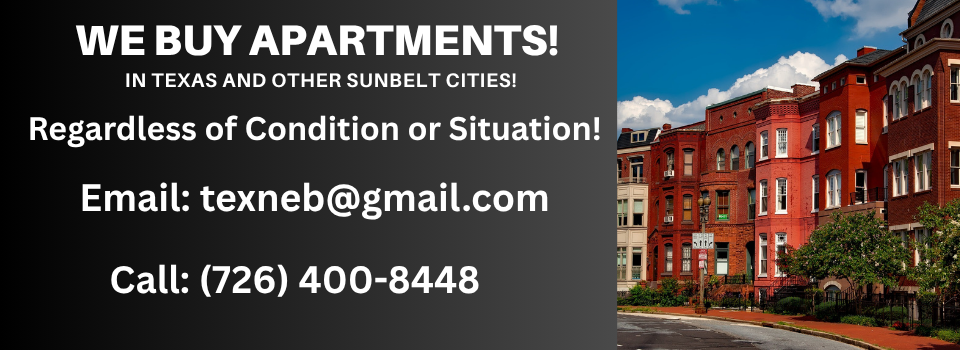“It’s tangible, it’s solid, it’s beautiful. It’s artistic, from my standpoint, and I just love real estate.”
Let me ask you a very simple, yet profound question: Why would you invest in real estate? Understanding the answer or answers to this question will help you along your investment career.
The following are a few common answers I have picked up on when I see this question asked:
Top 5 Financial Reasons to Invest in Commercial Real Estate
Let’s first look at the top 5 reasons to invest in real estate from strictly an investment standpoint:
1. Cash Flow – whether you buy with all cash or use today’s favorable financing with a low mortgage payment, positive monthly cash flow will occur when the monthly rent is greater than the monthly expenses. This gives you a monthly income from your real estate investment.
2. Appreciation – Appreciation is the increase in the property’s value, which generally occurs over time and can also be increased by an investor who adds value to the property through repairs and/or enhancements. This is also a great way to create equity in the property.
3. Depreciation – Even with an increase in the property’s value, the government allows owners a tax deduction on their property after they’ve owned the property for at least a year. This annual deduction is called depreciation which when added to the equation, protects the cash flow so that you receive some or all of it tax free. If you are an investor with an income from other sources such as a regular job, it can protect all or some of that income from state and/or federal income taxes. If you really want to understand how great this is, talk to an accountant.
4. Tax Benefits – In addition to depreciation, an investor can usually claim the interest portion of his monthly mortgage payment as a tax deduction.
5. Leverage – Leverage is a very powerful reason for investing in real estate. If an investor used 100% cash to acquire a house worth $100,000, and the house increased in value by $5,000 in one year, then the investor made a return of 5% (assuming no other costs in this case). However, if the investor obtained 80% financing, only $20,000 cash would be required at the closing table, and a bank or other lender would loan the remaining $80,000 to acquire the property. Assuming the same $5,000 increase in value, the investor’s cash contribution of $20,000 would yield a 25% return on investment ($5,000 increase in value divided by the $20,000 investment) in the same one year period of time.
With the above example, if the investor is able to bring in even a conservative amount of cash flow per month of $200, this will result in an additional $2,400 per year added to the increased appreciation. Your return for the year would now be $7,400 ($5,000 appreciation plus $2,400 cash flow) and your return on investment would now be 37% ($7,400 divided by $20,000). Even if the property value stayed stable with no appreciation, you would still see a positive return on your investment of the $2,400 in cash flow with a return on investment of 12%.
Adding to these benefits the low interest rates for financing and you can see how easy it is to accumulate wealth and become a successful investor.
Major Personal Reasons People Invest in Commercial Real Estate
Freedom:
Frankly, this is why most people start investing in real estate. They get star struck with the idea of riches that would give them the freedom to stop working for someone else. They may have a great job that they absolutely love that pays the bills but they still want to achieve long-term freedom. Or they may want extra money to eventually travel and do the things they want to do. And, if you buy and hold cash flow properties over time, sacrificing and delaying gratification, in five, ten or twenty years, you should have a pile of monthly cash flow and be able to attain that desired freedom.
Control:
Some investors I speak with want real estate to give them some level of control over their financial lives because, let’s face it, we have zero control in financial investments outside of real estate investing. If you invest in the stock market or money market funds, you don’t have any control over the return you may make on them. With real estate, there are things that you can do to control your return on investment as shown above.
Alternatives:
For some investors, real estate is nothing more than a portion of their overall investment portfolio. Perhaps you have divided your portfolio to include mutual funds, stocks, and real estate investment, etc. Or maybe you’re looking to achieve higher returns out of your cash through active management.
Career, Job, or Escape:
A few investors look at real estate investing as a career or a chance to own their own company. Others look at real estate as a means to eventually replace the job or career they may currently hate. And I’ve also seen many dive in head first, as if they’re running away from something versus running towards something.
Creating Value or Thrill of Hunt:
Many investors love the thrill of the deal and love telling you about the thrill of chasing a deal down or their last remodel. They pursue that addictive feeling and are always looking for the next rush or opportunity to turn another ugly duckling into a beautiful swan.
Options:
After many years of real estate investing, I have come to realize that in the end people love investing in real estate because it has given them so many more options. They have the options of continuing to work their current job, buying real estate as a full time career, and/or traveling, etc. The more they invest the more option doors open.
The Real Reason to Invest in Commercial Real Estate
People fall hard for the sexy pitch of earning freedom. Frankly, freedom is good but I think what people are really after is options. I believe that is why they keep working so hard to find the next deal, to find the next investor, and to keep building their growing portfolio.
Some might think freedom and options are the same things. But to me, freedom really means that they can stop doing something while options mean they can do other things. Having lived through this realization, I can tell you firsthand that having options is even better than having freedom. I would say you get freedom first, and then you build or acquire options.
As you read this, I hope you will be honest and figure out what Real Estate Investing means to you. I suspect that no matter why you think you are investing, if you peel back the onion, you are really looking to create options for you and your family.
Good luck in your investing, no matter your reasons!
As I say throughout my blogs, if I may be of assistance with your real estate questions, please contact me…I truly want to help. My way of giving back is to give away my knowledge. Thank you for visiting my blog.


